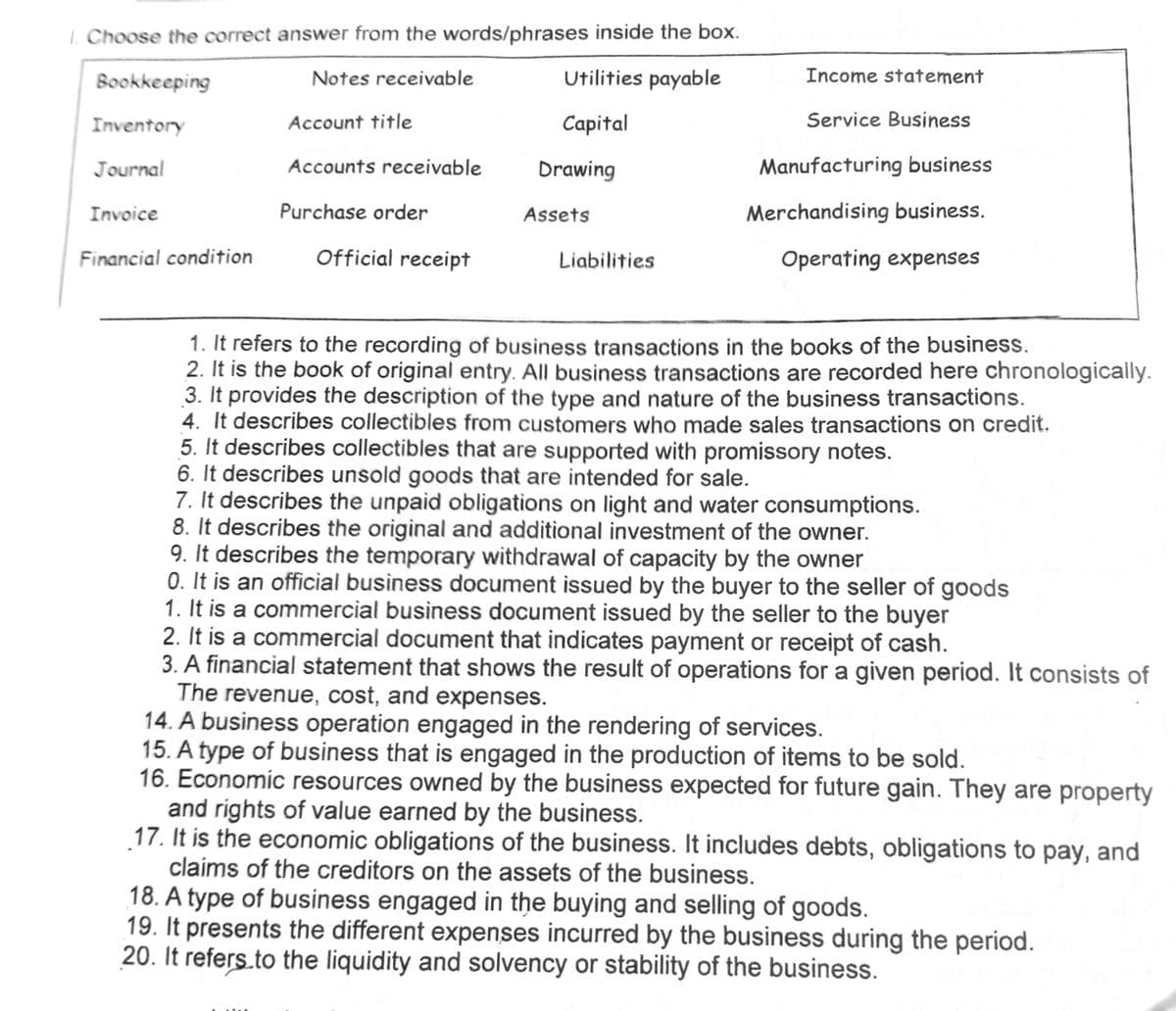1. Choose the correct answer from the words/phrases inside the box. Notes receivable Utilities payable Capital Bookkeeping Inventory Journal Invoice Financial condition Account title Accounts receivable Purchase order Official receipt Drawing Assets Liabilities Income statement Service Business Manufacturing business Merchandising business. Operating expenses 1. It refers to the recording of business transactions in the books of the business. 2. It is the book of original entry. All business transactions are recorded here chronological 3. It provides the description of the type and nature of the business transactions. 4. It describes collectibles from customers who made sales transactions on credit. 5. It describes collectibles that are supported with promissory notes. 6. It describes unsold goods that are intended for sale. 7. It describes the unpaid obligations on light and water consumptions. 8. It describes the original and additional investment of the owner. 9. It describes the temporary withdrawal of capacity by the owner 0. It is an official business document issued by the buyer to the seller of goods 1. It is a commercial business document issued by the seller to the buyer 2. It is a commercial document that indicates payment or receipt of cash. 3. A financial statement that shows the result of operations for a given period. It consists The revenue, cost, and expenses. 14. A business operation engaged in the rendering of services. 15. A type of business that is engaged in the production of items to be sold. 16. Economic resources owned by the business expected for future gain. They are proper and rights of value earned by the business. 17. It is the economic obligations of the business. It includes debts, obligations to pay, and claims of the creditors on the assets of the business. 18. A type of business engaged in the buying and selling of goods. 19. It presents the different expenses incurred by the business during the period. 20. It refers to the liquidity and solvency or stability of the business.
The Effect Of Prepaid Taxes On Assets And Liabilities
Many businesses estimate tax liability and make payments throughout the year (often quarterly). When a company overestimates its tax liability, this results in the business paying a prepaid tax. Prepaid taxes will be reversed within one year but can result in prepaid assets and liabilities.
Final Accounts
Financial accounting is one of the branches of accounting in which the transactions arising in the business over a particular period are recorded.
Ledger Posting
A ledger is an account that provides information on all the transactions that have taken place during a particular period. It is also known as General Ledger. For example, your bank account statement is a general ledger that gives information about the amount paid/debited or received/ credited from your bank account over some time.
Trial Balance and Final Accounts
In accounting we start with recording transaction with journal entries then we make separate ledger account for each type of transaction. It is very necessary to check and verify that the transaction transferred to ledgers from the journal are accurately recorded or not. Trial balance helps in this. Trial balance helps to check the accuracy of posting the ledger accounts. It helps the accountant to assist in preparing final accounts. It also helps the accountant to check whether all the debits and credits of items are recorded and posted accurately. Like in a balance sheet debit and credit side should be equal, similarly in trial balance debit balance and credit balance should tally.
Adjustment Entries
At the end of every accounting period Adjustment Entries are made in order to adjust the accounts precisely replicate the expenses and revenue of the current period. It is also known as end of period adjustment. It can also be referred as financial reporting that corrects the errors made previously in the accounting period. The basic characteristics of every adjustment entry is that it affects at least one real account and one nominal account.
Only answer

Trending now
This is a popular solution!
Step by step
Solved in 3 steps









